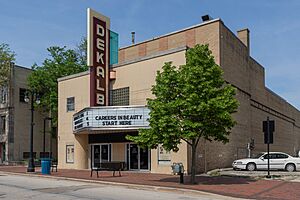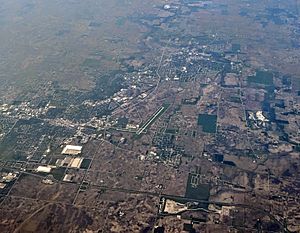DeKalb, Illinois facts for kids
Quick facts for kids
DeKalb, Illinois
|
|||
|---|---|---|---|

The Egyptian Theatre in Downtown DeKalb
|
|||
|
|||
| Nickname(s):
Barb City
|
|||
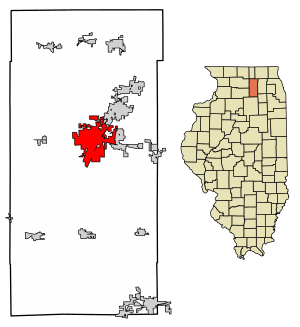
Location of DeKalb in DeKalb County, Illinois
|
|||
| Country | United States | ||
| State | Illinois | ||
| County | DeKalb | ||
| Incorporated | 1856 | ||
| Named for | Johann de Kalb | ||
| Area | |||
| • City | 17.12 sq mi (44.33 km2) | ||
| • Land | 16.95 sq mi (43.91 km2) | ||
| • Water | 0.17 sq mi (0.43 km2) | ||
| Elevation | 879 ft (268 m) | ||
| Population
(2020)
|
|||
| • City | 40,290 | ||
| • Density | 2,376.71/sq mi (917.66/km2) | ||
| • Urban | 68,545 | ||
| Time zone | UTC−6 (CST) | ||
| • Summer (DST) | UTC−5 (CDT) | ||
| ZIP codes |
60115
|
||
| Area code(s) | 815 | ||
| FIPS code | 17-19161 | ||
| Public Transit | DeKalb Public Transit | ||
DeKalb is a city in DeKalb County, Illinois, United States. About 40,000 people lived there in 2020. The city is named after Johann de Kalb, a brave war hero from long ago. He fought during the American Revolutionary War.
DeKalb was founded in 1856. It became very important for making barbed wire, which is used for fences. This was especially helpful for farms and raising animals. Today, DeKalb still has some farm-related businesses. It also has many health and service jobs. The biggest employer in the city is Northern Illinois University, which started in 1895. DeKalb is about 65 miles (105 km) west of downtown Chicago.
Contents
History of DeKalb
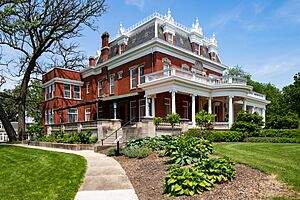
DeKalb was first called Huntley's Grove. It was officially mapped out in 1853. The city got its name from Baron Johann de Kalb. He was a major general in the American Revolutionary War. The first church in DeKalb was started in 1844.
In 1846, a stagecoach route connected Chicago to DeKalb and other towns. A post office opened in DeKalb in 1849. The first railroad tracks reached the city in 1853.
Barbed Wire and Farming Innovations
Barbed wire was a very important product in DeKalb's history. Joseph Glidden (1813–1906) lived in DeKalb. In 1874, he received a special paper called a patent. This patent was for his invention of the common double-strand barbed wire. This type of wire is still used all over the world today.
Glidden and Isaac L. Ellwood (1833–1910) started making barbed wire in DeKalb. Their first company was called the Barb Fence Company. Later, their companies grew and merged with bigger ones. Glidden and Ellwood also helped start the state teachers college. This college later became Northern Illinois University.
DeKalb also played a big part in developing special hybrid corn. This type of corn produces more crops. The DeKalb Genetics Corporation started making large amounts of high-yield corn seeds in 1934. For many years, more American farmers planted DeKalb hybrid corn than any other brand. The company's logo was a flying ear of corn. Today, the DeKalb brand of farm products is owned by a company called Bayer.
Geography and Climate
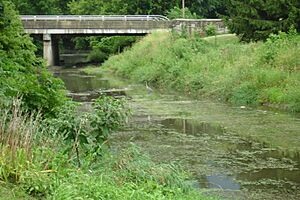
DeKalb is located in northern Illinois. It is about 65 miles (105 km) west of downtown Chicago. It is also 30 miles (48 km) southeast of Rockford. The South Branch Kishwaukee River flows north through DeKalb.
The city covers about 17.12 square miles (44.33 km²). Most of this area is land. A small part is water, like rivers and lakes.
On August 24, 2007, the Kishwaukee River in DeKalb flooded. The water rose very high, causing a lot of damage. This was one of the highest flood levels ever recorded for the river.
DeKalb's Weather
DeKalb has a humid continental climate. This means it has four clear seasons. Summers can be hot. Winters are cold and often have snow. Rain and snow fall fairly evenly throughout the year. Spring and summer can have strong thunderstorms.
| Climate data for DeKalb, Illinois (1991–2020 normals, extremes 1966–present) | |||||||||||||
|---|---|---|---|---|---|---|---|---|---|---|---|---|---|
| Month | Jan | Feb | Mar | Apr | May | Jun | Jul | Aug | Sep | Oct | Nov | Dec | Year |
| Record high °F (°C) | 63 (17) |
69 (21) |
84 (29) |
92 (33) |
96 (36) |
101 (38) |
102 (39) |
103 (39) |
94 (34) |
89 (32) |
76 (24) |
69 (21) |
103 (39) |
| Mean daily maximum °F (°C) | 28.1 (−2.2) |
32.5 (0.3) |
45.0 (7.2) |
58.6 (14.8) |
70.2 (21.2) |
79.9 (26.6) |
83.1 (28.4) |
81.2 (27.3) |
74.9 (23.8) |
62.0 (16.7) |
46.3 (7.9) |
33.6 (0.9) |
57.9 (14.4) |
| Daily mean °F (°C) | 20.6 (−6.3) |
24.5 (−4.2) |
35.9 (2.2) |
48.0 (8.9) |
59.7 (15.4) |
69.7 (20.9) |
73.2 (22.9) |
71.3 (21.8) |
64.0 (17.8) |
51.5 (10.8) |
37.9 (3.3) |
26.3 (−3.2) |
48.5 (9.2) |
| Mean daily minimum °F (°C) | 13.1 (−10.5) |
16.6 (−8.6) |
26.8 (−2.9) |
37.3 (2.9) |
49.2 (9.6) |
59.5 (15.3) |
63.3 (17.4) |
61.3 (16.3) |
53.2 (11.8) |
41.0 (5.0) |
29.6 (−1.3) |
19.1 (−7.2) |
39.2 (4.0) |
| Record low °F (°C) | −27 (−33) |
−26 (−32) |
−13 (−25) |
8 (−13) |
24 (−4) |
34 (1) |
43 (6) |
39 (4) |
27 (−3) |
13 (−11) |
−8 (−22) |
−22 (−30) |
−27 (−33) |
| Average precipitation inches (mm) | 1.69 (43) |
1.71 (43) |
2.24 (57) |
3.56 (90) |
4.79 (122) |
4.57 (116) |
4.00 (102) |
4.06 (103) |
3.32 (84) |
2.96 (75) |
2.31 (59) |
2.04 (52) |
37.25 (946) |
| Average snowfall inches (cm) | 10.2 (26) |
8.7 (22) |
4.4 (11) |
1.3 (3.3) |
0.0 (0.0) |
0.0 (0.0) |
0.0 (0.0) |
0.0 (0.0) |
0.0 (0.0) |
0.1 (0.25) |
1.8 (4.6) |
6.6 (17) |
33.1 (84) |
| Average precipitation days (≥ 0.01 in) | 9.8 | 8.4 | 9.8 | 12.3 | 12.9 | 11.0 | 10.1 | 9.0 | 9.0 | 10.2 | 8.6 | 10.3 | 121.4 |
| Average snowy days (≥ 0.1 in) | 7.0 | 5.2 | 3.0 | 0.7 | 0.0 | 0.0 | 0.0 | 0.0 | 0.0 | 0.1 | 1.7 | 6.0 | 23.7 |
| Source: NOAA | |||||||||||||
People of DeKalb
In 2020, DeKalb had about 40,290 people living there. The city is home to many different groups of people. About 58% of the people were White, and about 18% were African American. There were also people of Asian, Native American, and other backgrounds. About 17% of the population was Hispanic or Latino.
The city has many families and also many college students. About 18% of the people were under 18 years old. A large part of the population, about 31%, was between 18 and 24 years old. This is because of the university in the city. The average age in DeKalb was about 25 years old.
| Historical population | |||
|---|---|---|---|
| Census | Pop. | %± | |
| 1880 | 1,598 | — | |
| 1890 | 2,579 | 61.4% | |
| 1900 | 5,904 | 128.9% | |
| 1910 | 8,102 | 37.2% | |
| 1920 | 7,871 | −2.9% | |
| 1930 | 8,545 | 8.6% | |
| 1940 | 9,146 | 7.0% | |
| 1950 | 11,708 | 28.0% | |
| 1960 | 18,486 | 57.9% | |
| 1970 | 32,949 | 78.2% | |
| 1980 | 33,099 | 0.5% | |
| 1990 | 34,925 | 5.5% | |
| 2000 | 39,018 | 11.7% | |
| 2010 | 43,862 | 12.4% | |
| 2020 | 40,290 | −8.1% | |
| Census Quickfacts [1] | |||
Economy and Jobs
DeKalb's biggest employer is Northern Illinois University. It is the third-largest college campus in Illinois. Other major employers include Northwestern Medicine, General Electric, and Monsanto (which used to be DeKalb Corn). The local school district also employs many people. There are also many stores along Illinois Route 23.
DeKalb has large warehouses for big companies. These include Target, 3M, Nestlé, and Ferrara Candy Company. These companies like DeKalb because it is close to major highways like I-88 and I-39. The 3M complex helps send products to many parts of the world.
In 2020, a company called Meta announced it would build a large data center in DeKalb. This project is worth $800 million.
Arts and Culture
DeKalb hosts an event called Corn Fest every year. It usually happens in late August.
The Egyptian Theatre was built in 1929. It is one of the few theaters of its kind still open in the United States. The Stage Coach Players, a theater group, started in 1947. They have their own theater on 5th Street.
Parks and Recreation
The DeKalb Park District takes care of DeKalb's 44 parks and recreation places. This park district was started in 1935. It was created because people wanted a public swimming pool. The city gave the first four parks to the District. These were Annie's Woods, Huntley Park, Liberty Park, and Hopkins Park.
In 2000, the district opened the Sports and Recreation Center. This is a large building with an indoor field. It has a special turf surface. The park district offers many sports and fun programs all year. These include summer camps, baseball, softball, swimming, golf, and basketball.
The DeKalb Park District has over 700 acres of parks. These include community parks, neighborhood parks, and long, narrow parks along rivers. Some well-known parks and places are:
- River Heights Golf Course
- Buena Vista Golf Course
- Hopkins Park Pool and Community Center
- Nehring Center for Culture and Tourism
- Ellwood House Museum and Park
Education in DeKalb

DeKalb has 11 public schools, one private school, one university, and one public library.
Schools for Kids
DeKalb Community Unit School District 428 runs the public schools. There are eight elementary schools for grades K–5. Clinton Rosette and Huntley are middle schools for grades 6–8. DeKalb High School is for grades 9–12. Its sports teams are called the Barbs.
Colleges and Universities
Northern Illinois University (NIU) was founded in DeKalb in 1895. It was first called the Northern Illinois State Normal School. NIU is a large teaching and research university. It has about 20,000 students. This makes NIU the third-largest college campus in Illinois.
Getting Around DeKalb
Trains
The first train tracks came to DeKalb on August 22, 1853. Later, this line became part of a major railway from Chicago to Omaha. Passenger trains used this line until 1971. A train station was built in 1891.
Today, the closest passenger train service is in Elburn. This is about 15 miles (24 km) east of DeKalb. You can get there by bus. In 2023, the DeKalb City Council decided to study if train service could be extended to the city. This study showed that it was possible. DeKalb is also looking into bringing back Amtrak train service that stopped in the 1970s.
Roads
The famous Lincoln Highway was built through DeKalb in 1913. The first "seedling mile" of concrete road was built near Malta, west of DeKalb, in 1914. The rest of the Lincoln Highway in DeKalb County was paved by 1920. This highway is now part of Illinois Route 38.
The main north-south road in DeKalb is Illinois Route 23. Interstate Highway 88 was finished near DeKalb around 1975. It passes just south of the city. This highway has toll plazas and a service area with restaurants and a gas station. Using this highway, DeKalb is about 30 miles (48 km) west of Aurora and 65 miles (105 km) west of downtown Chicago.
Buses
Local bus service in DeKalb is provided by DeKalb Public Transit. This is a team effort between the city and Northern Illinois University. Bus routes go through the university, the city, and Sycamore. Some routes even go to Kishwaukee College and the train station in Elburn. The bus schedules change depending on whether the university is in session. This bus system started in 1971.
Airport
DeKalb Taylor Municipal Airport (DTMA) is on the east side of the city. It is used for smaller planes, not big commercial flights. The airport opened in 1944. The city took over the airport in 1948. There are no direct commercial flights to DeKalb. However, O'Hare International Airport in Chicago is about 43 miles (70 km) away. This makes it easy to fly to and from DeKalb.
Famous People from DeKalb
Many notable people have come from DeKalb:
- George Franklin Barber, a famous architect.
- A. J. Bramlett, a former professional basketball player.
- Cindy Crawford, a world-famous model and actress.
- Joseph Glidden, the inventor of barbed wire.
- Jacob Haish, another inventor of barbed wire.
- Barbara Hale, an actress known for the Perry Mason TV show.
- Richard Jenkins, an actor nominated for Academy Awards.
- Alan and Dale Klapmeier, who started the Cirrus Design Corporation, a company that makes airplanes.
- Karl Nelson, a football player for the New York Giants.
- Mel Owens, a football player for the Los Angeles Rams.
- Richard Powers, an author who won a National Book Award.
- W. Willard Wirtz, who was the United States Secretary of Labor.
See also
 In Spanish: DeKalb para niños
In Spanish: DeKalb para niños






